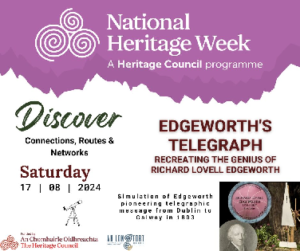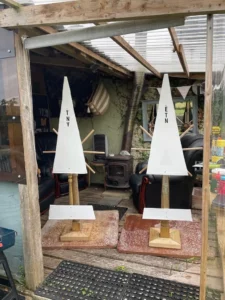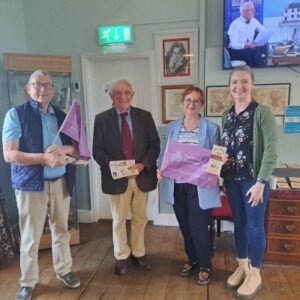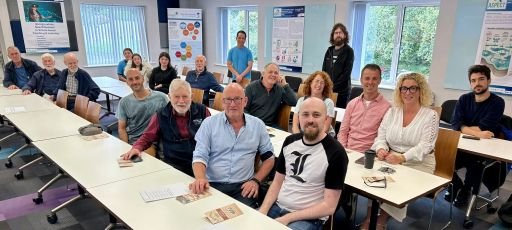


Heritage Week 2024, with its theme “Connections, Routes & Networks,” kicked off with the simulation of Edgeworth’s Optical Telegraph event from 1804.
On 17th August, the first day of Heritage Week, history was revived through a remarkable simulation connecting the Royal Hospital Kilmainham in Dublin to the Insight Centre for Data Analytics at the University of Galway.
>> Watch the recreation on YouTube
Ray Jordan and his team took on the ambitious challenge of simulating Edgeworth’s Optical Telegraph, a pioneering telegraphic system that once linked Dublin to Galway. This modern recreation offered a unique opportunity to step back in time and appreciate the incredible achievements of Richard Lovell Edgeworth, his daughter Maria, and Admiral Francis Beaufort.
In 1804, Richard Lovell Edgeworth accomplished something extraordinary: he sent a signal from Dublin to Galway and back in less than 30 minutes. Although this might seem routine today, in an era when communication was slow and laborious, it was nothing short of revolutionary. Edgeworth’s Optical Telegraph, utilising a series of semaphore towers, relayed messages across great distances far faster than traditional methods. Consequently, this achievement represented the culmination of years of effort and innovation, driven by Edgeworth’s vision to improve communication across Ireland.
Recreating Edgeworth’s Optical Telegraph from Dublin to Galway in 2024 posed its own set of challenges. The team first had to transport the carefully constructed semaphore units—one to Dublin and the other to Galway. Additionally, they needed to purchase and set up extra equipment, including a screen in Dublin. Subsequently, the team conducted numerous test runs to ensure that the signal strength and fidelity met their high standards. Meanwhile, emails and phone calls flew between all involved parties, as they worked tirelessly to ensure everything was ready for the big day.

This extensive preparation led us to reflect on the immense effort required for the original event. Back in 1804, constructing multiple semaphore towers, organising equipment, and training operators to use this new technology was a monumental task. Operators needed meticulous training to read, record, and accurately transmit messages. Indeed, any failure in the system could render the entire message meaningless. While our team had the luxury of instant communication to troubleshoot issues, Edgeworth’s team had to rely on much slower methods, which could potentially delay the process by days.
The 2024 simulation faced its share of challenges. However, we benefited from modern technology, allowing us to address issues quickly. In contrast, Richard Lovell Edgeworth, in 1804, encountered significant difficulties. Nevertheless, he drew strength from previous successes. For example, he had successfully sent signals from Edgeworthstown to Tullynally Castle, and his sons had transmitted messages from Donaghadee in County Down to Portpatrick in Scotland. Consequently, these early trials helped Edgeworth refine his system and ultimately paved the way for the successful Dublin to Galway transmission.

Despite the success of Edgeworth’s Optical Telegraph, it took him ten years to persuade the government to support his signalling system. Sadly, after the 1804 test, the government scrapped the project, halting further development. It’s intriguing to consider how far Edgeworth might have advanced his telegraph system with continued support. Although the system had its flaws—vulnerability to bad weather and human error—it was a remarkable prototype that laid the groundwork for future communication technologies.
Our 2024 recreation of Edgeworth’s Optical Telegraph served as a fitting tribute to a momentous achievement in communication history. This project would not have succeeded without the support of the Heritage Council, our Heritage Officer Mairead Ni Chonghaile, and Longford County Council. Special thanks go to Ray Jordan and his family, who played a pivotal role in driving this project forward, building the semaphores, and organising the communications. We also extend our gratitude to Brendan Smith at the Insight Centre for Data Analytics, University of Galway, for managing the Galway end of the event, and to Dr. Joanna Wharton of York University and UCC for her invaluable historical insights.

Finally, we want to thank everyone who attended the event, both in person in Dublin, Edgeworthstown, and Galway, as well as those who joined us online from across the globe. Your support made this historic recreation possible, reminding us all of the incredible advancements Richard Lovell Edgeworth achieved and the lasting impact of Edgeworth’s Optical Telegraph.
